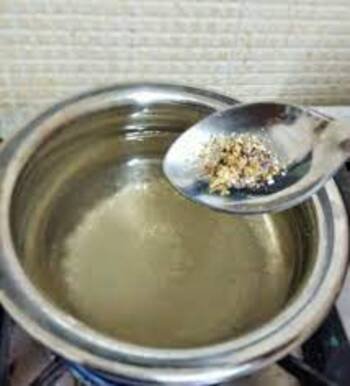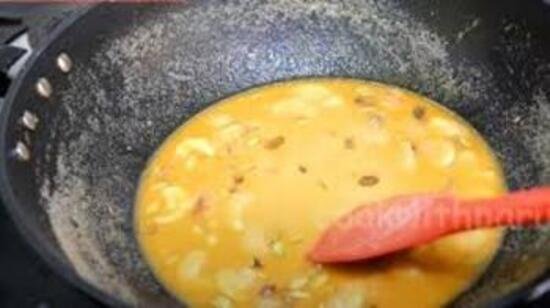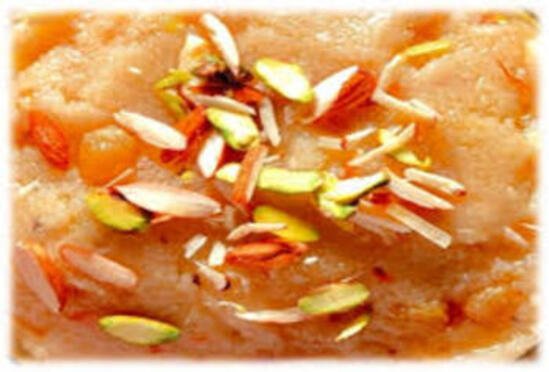What is Sooji Halwa
Sooji Halwa is a popular Indian dessert made from semolina (sooji), ghee (clarified butter), sugar, and water or milk. It’s often flavored with cardamom and garnished with nuts and raisins. The dish is cooked by roasting the semolina in ghee until golden brown, then adding sugar and liquid, and cooking until the mixture thickens into a soft, smooth pudding-like consistency. It’s commonly served during festivals, religious ceremonies, and special occasions.
The origion of Sooji Halwa
It started out in the Middle East, but now you can find it almost everywhere. In India, they love Sooji Halwa, which is a creamy semolina pudding.
In India, Sooji Halwa is often prepared during religious festivals, special occasions, and as a prasad (offering) in temples. It is particularly popular in North India and is known as “Sheera” in some regions.
In Pakistan, Sooji Halwa is also a popular dessert, often served as part of breakfast alongside puri (fried bread), known as “Halwa Puri.”
Similar versions of Sooji Halwa are found in Bangladesh and Nepal, where it is enjoyed during festivals and special events.
Sooji Halwa’s simple ingredients and quick preparation make it a beloved dish across the Indian subcontinent, with each region adding its unique touch to the recipe.
The Pakistani sooji halwa recipe involves roasting semolina (sooji) in ghee until it turns golden brown, releasing a rich, nutty aroma. To make sooji halwa, sugar and milk are then added to the roasted semolina, creating a creamy and luscious texture.
The halwa is typically flavored with cardamom and garnished with a generous sprinkle of nuts and raisins, adding both fragrance and a delightful crunch to each bite. Pakistan has a bunch of different halwa too, from Gajar Halwa/ Carrot Hlwa to a nutty kind, Daal Moon Halwa, Badam Halwa, Bread Halwa.
How to make Sooji Halwa
It’s the cooking method that creates the wonder of this dish. Sugar, ghee (that’s clarified butter), and sometimes milk or water are simmered slowly with the Soji, cardamom or saffron. As it cooks, it thickens up and gets this smooth, rich texture.
You can whip up a delicious batch of halva in under 15 minutes! No crazy ingredients or complicated steps involved. You might just find your new favorite way to end a meal (or start your day, we won’t judge!).
So there you have it! With these simple steps, you can create a delicious and creamy Soji Halwa in your kitchen. It’s sure to become a family favorite!
For more delicious dessert recipes click the links below!
Strawberry Angel Food Cake Dessert
Easy Gulab Jamun recipe with milk powder
Air fryer chocolate chip cookies
Frequently Asked Questions ( FAQ’s)
What is Sooji Halwa called in English?
Suji Halwa (samolina pudding) also known as sheera. It is a traditional Indian pudding made with semolina , ghee, sugar, cashews, and raisins. This simple yet delicious dessert has a fluffy and soft texture, complemented by the delicate flavors of cardamom and ghee.
Which halwa is famous in Pakistan?
Sohan Halwa from Multan is most famous in Pakistan.
Is Semolina same as Sooji?
Yes Sooji is also known as samolina.
Sooji Halwa (Semolina Pudding)
Description
Ingredients
How to Make Halwa: A Deliciously Simple Guide
Instructions
-
Roast Soji:
1. Grab your pan and heat up the ghee over medium heat.
2. Once it's nice and warm, add the soji. Keep stirring it constantly.
3. After 3 minutes of roasting, add the nuts along with the sooji. This will allow the nuts to roast and release their flavor along with the sooji.
4. Just make sure to keep stirring everything constantly until it turns a beautiful golden brown. Be careful not to burn it!
-
Make Sugar Syrup:
While the soji is getting its golden tan, in another pan, mix together the water and sugar over medium heat. Add crushed cardamom. Stir it around until all the sugar crystals disappear. This creates our sweet syrup!
-
Adding Sugar Syrup and Simmering:
Once the soji is golden brown and toasty, slowly pour the sugar syrup into the pan. Be careful, it might sizzle a bit! That's okay, just be gentle. Turn down the heat to low, add yellow color or saffron and keep stirring the mixture constantly.
-
Cook to get Perfect Thickness:
Cover and cook it until thicken up like porridge, this might take about 10-15 minutes. As the halwa cooks, it will release its oil.
-
Garnishing:
When it reaches that perfect thickness, take the pan off the heat.
Sprinkle some chopped nuts and raisins on top for an extra taste and texture (totally optional, but highly recommended!).
-
Serving Suggestions:
Serve hot with pories (fried bread) in break fast or enjoy as a dessert.
Nutrition Facts
Serving Size 100g
- Amount Per Serving
- Calories 285kcal
- % Daily Value *
- Total Carbohydrate 150g50%
- Sugars 90g
- Protein 10g20%
* Percent Daily Values are based on a 2,000 calorie diet. Your daily value may be higher or lower depending on your calorie needs.
Note
- Roast the Base: Roast the chosen base ingredient (sooji, carrots, etc.) in ghee or oil over medium heat, stirring constantly, until golden brown and fragrant. This is crucial for developing flavor and texture.
- Traditionally, sugar is the go-to sweetener for halwa. However, some recipes offer a twist with condensed milk or honey. Feel free to adjust the amount to suit your preference for sweetness.
- Consistency: If the halwa becomes too thick, add a little more hot water or milk to adjust.
- Base Options: You can use semolina (sooji), grated carrots, lentils, or even vegetables like bottle gourd for the base.
- Gradual Addition: Slowly add the hot sugar syrup to the roasted base ingredient, stirring continuously to avoid lumps.










